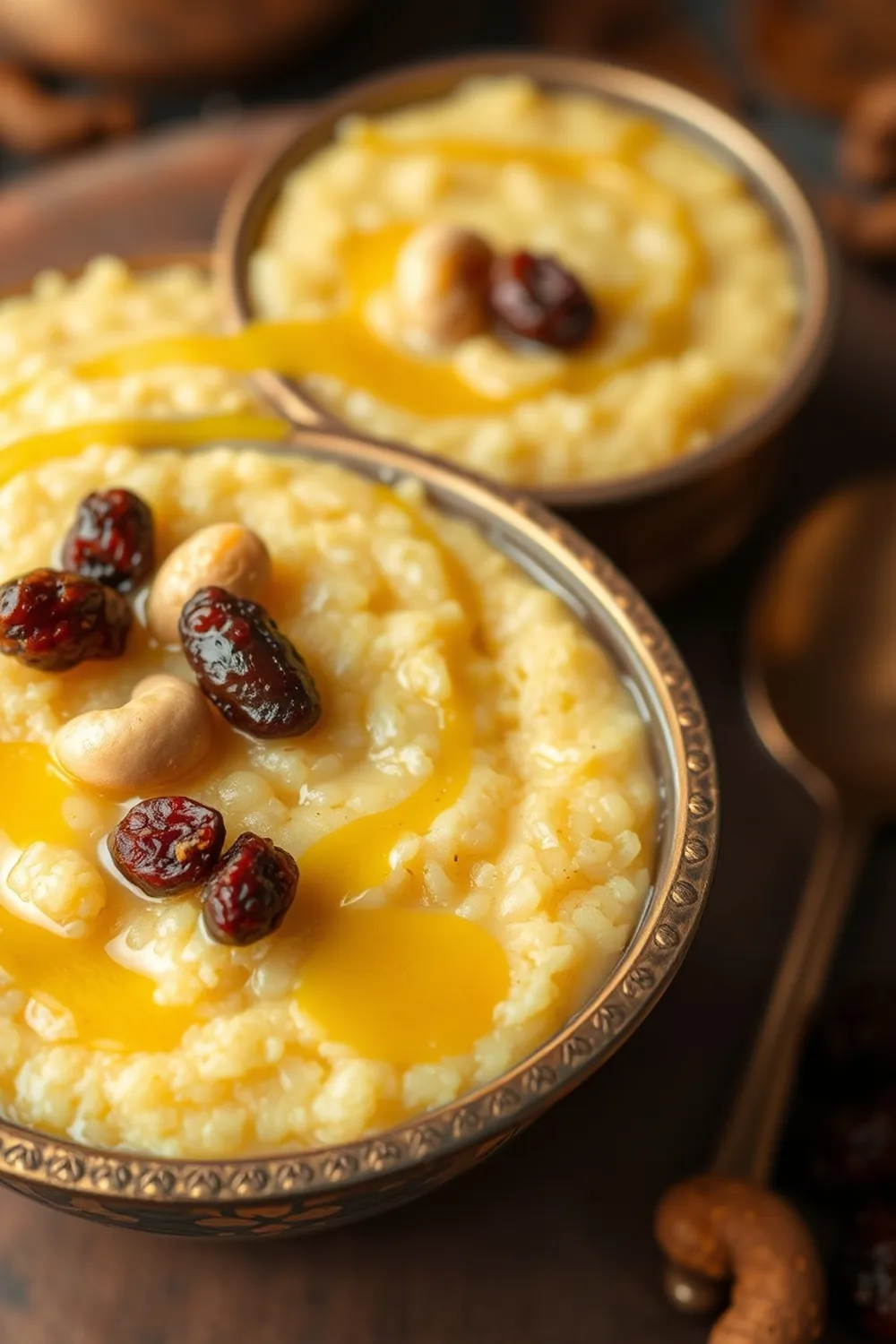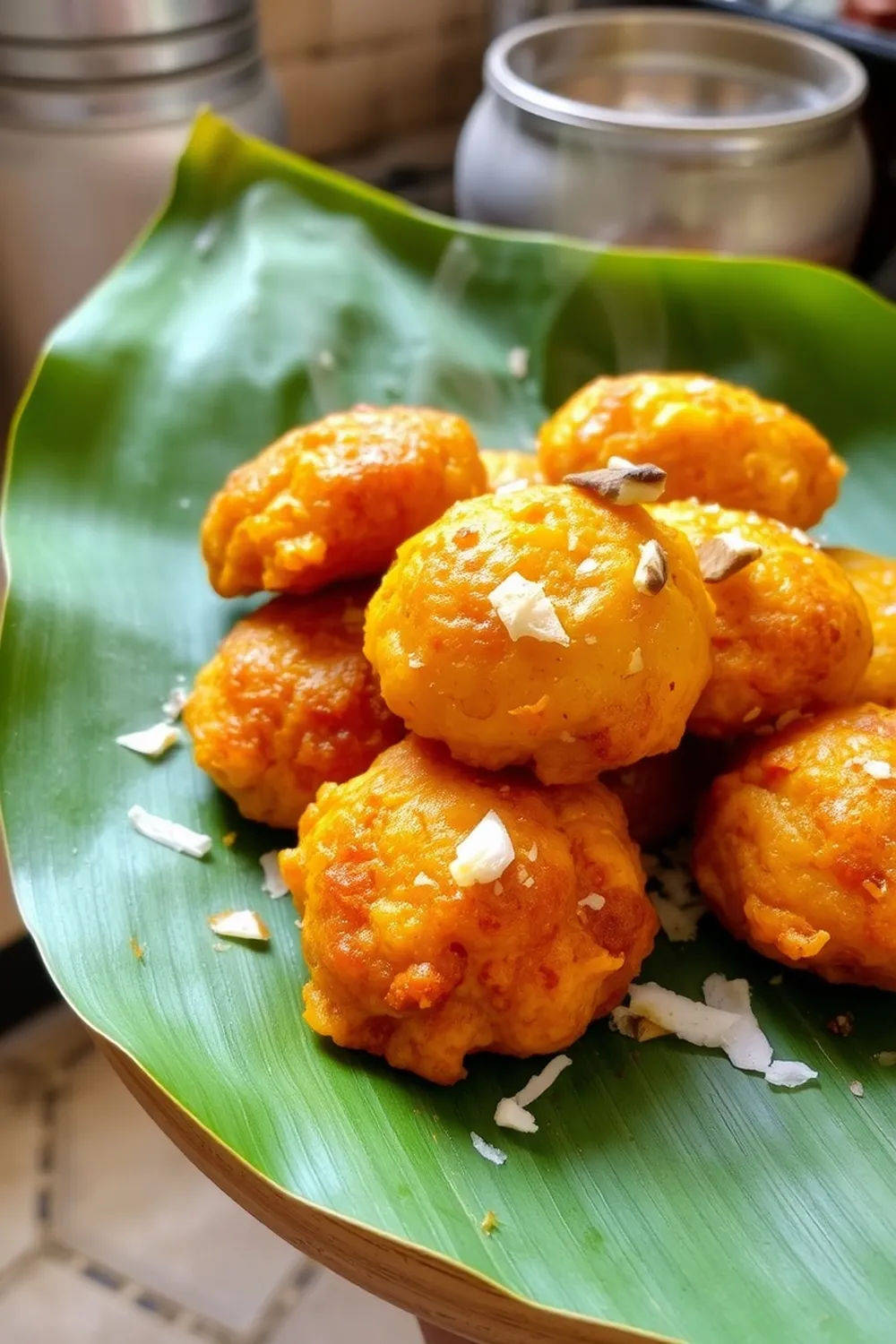- Boil milk in a heavy-bottomed pan. Add vinegar-water mixture and stir gently to curdle the milk into chena. Avoid adding ice cubes directly.
- Strain the chena using muslin cloth, rinse with cold water, and let it rest for at least 30 minutes to remove excess water.
- Knead the chena for 7-10 minutes until smooth and pliable. Set aside.
- In a pan, melt the khoya and jaggery on medium-low heat, stirring constantly until completely melted and smooth.
- Add the chena to the pan and stir continuously for 5-7 minutes until a thick, non-sticky dough forms.
- Cool the mixture slightly, then shape into desired balls or press into greased molds.
- Let the sondesh set at room temperature for at least 2 hours, or until firm, before storing in the refrigerator.
- Calories:75 kcal25%
- Energy:313 kJ22%
- Protein:3 g28%
- Carbohydrates:8 mg40%
- Sugar:6 mg8%
- Salt:30 g25%
- Fat:4 g20%
Last Updated on 2 months by Neha Deshmukh
Authentic Sondesh Recipe – Khoya & Jaggery Indian Sweet
Introduction
Oh, Sondesh. Just the name conjures up images of sweet, milky goodness, doesn’t it? This Bengali sweet is a classic for a reason, and honestly, it’s one I’ve been perfecting for years. I first attempted Sondesh during a particularly festive Durga Puja, and while it wasn’t quite right then, it sparked a love affair with this delicate dessert. Today, I’m sharing my go-to recipe for Khoya & Jaggery Sondesh – a truly authentic taste of India. It’s a little bit of effort, but trust me, the reward is so worth it.
Why You’ll Love This Recipe
This Sondesh recipe isn’t just about sweetness; it’s about texture and tradition. The combination of rich khoya, fragrant jaggery, and the soft, melt-in-your-mouth chena is simply divine. It’s perfect for festivals, special occasions, or just when you need a little something to brighten your day. Plus, making Sondesh is a wonderfully satisfying process – a little bit of kitchen magic, really!
Ingredients
Here’s what you’ll need to create this delightful treat:
- 1 lt Milk
- Few ice cubes
- 2 tablespoons White vinegar
- 2 tablespoons Water
- 4.85 oz (approx. 138g) Date palm jaggery (Nolen Gur/Patali Gur)
- 3.7 oz (approx. 105g) Khoya/Mawa (solid milk)
- Little ghee (to grease mold)
Ingredient Notes
Let’s talk ingredients – getting these right makes all the difference!
Khoya (Mawa) – Types and Quality
Khoya, or mawa, is the heart of this recipe. You’ll find different types – besan khoya (made with gram flour) and milk khoya (made purely from reducing milk). For the most authentic flavor, go for milk khoya. Look for a good quality khoya that’s fresh and doesn’t smell sour.
Date Palm Jaggery (Nolen Gur/Patali Gur) – Regional Variations & Substitutes
Nolen Gur (in Bengal) or Patali Gur (elsewhere) is a date palm jaggery that gives Sondesh its unique flavor. It’s a seasonal ingredient, so if you can’t find it, you can substitute with regular jaggery, but the taste will be slightly different. Dark brown sugar can also work in a pinch, but again, it won’t have that same distinctive caramel-like depth.
Milk – Full Fat vs. Toned
Full-fat milk is highly recommended for making chena. It yields a softer, more flavorful cheese. While toned milk can be used, the chena might be a little crumbly.
White Vinegar – Importance of Quality
Use good quality white vinegar. It helps in curdling the milk effectively. Avoid using flavored vinegars.
Step-By-Step Instructions
Alright, let’s get cooking!
- First, pour the milk into a heavy-bottomed pan and bring it to a boil. Keep an eye on it so it doesn’t overflow!
- Once boiling, reduce the heat to medium-low. Now, here’s the magic: slowly add the ice cubes and the vinegar-water mixture. Stir gently. You’ll see the milk start to curdle, separating into chena (cheese) and whey (watery liquid).
- Line a colander with a clean muslin cloth. Carefully pour the curdled milk into the cloth.
- Gather the edges of the cloth and tie it into a bundle. Gently squeeze out all the excess whey. Don’t be too rough, though!
- Rinse the chena under cold water to remove any lingering vinegar taste. Then, hang the bundle for about 30 minutes to let it drain completely.
- Now for the kneading! Transfer the chena to a clean surface and knead it for 7-10 minutes until it becomes smooth and silky. This is important for a soft Sondesh.
- In a separate pan, melt the grated khoya and jaggery over medium-low heat. Stir constantly until it becomes a runny, smooth mixture.
- Add the kneaded chena to the pan with the khoya-jaggery mixture. Now, the real work begins! Stir continuously for about 5 minutes until everything comes together and forms a thick, dough-like consistency.
- Remove the pan from the heat and let the mixture cool slightly. Once it’s cool enough to handle, shape it into small balls or press it into greased molds. I love using little flower-shaped molds for a traditional look.
- Let the Sondesh set at room temperature for about 2 hours to firm up. Then, they’re ready to enjoy!
Expert Tips
- Don’t overcook the chena-khoya mixture, or the Sondesh will become rubbery.
- Greasing the molds well is crucial for easy removal.
- If the mixture is too sticky, chill it in the fridge for 15-20 minutes before shaping.
Variations
Sondesh is surprisingly versatile! Here are a few ways to customize it:
Vegan Sondesh Adaptation
My friend Priya, who’s vegan, loves a version made with cashew cheese and plant-based milk. It takes a bit of tweaking, but it’s totally doable!
Gluten-Free Sondesh
This recipe is naturally gluten-free, which is fantastic! Just double-check that your khoya doesn’t have any hidden gluten ingredients.
Spice Level Variation (Cardamom Infusion)
My grandmother always added a pinch of cardamom powder to her Sondesh. It adds a lovely warmth and fragrance. About ¼ teaspoon should do the trick.
Festival Adaptations (Makar Sankranti, Durga Puja)
During Makar Sankranti, some families add sesame seeds to the Sondesh. For Durga Puja, it’s often served as an offering to the goddess.
Serving Suggestions
Sondesh is best enjoyed at room temperature. It pairs beautifully with a cup of masala chai or a glass of cold milk. It’s also lovely served alongside other Bengali sweets like mishti doi.
Storage Instructions
Store Sondesh in an airtight container in the refrigerator for up to 3-4 days. It tends to dry out a bit over time, so it’s best enjoyed fresh.
FAQs
What is Sondesh and where does it originate from?
Sondesh is a traditional Bengali sweet made from chena (Indian cheese), sugar (or jaggery), and khoya. It originated in Bengal, India, and has been a beloved treat for centuries.
Can I use regular sugar instead of jaggery in this Sondesh recipe?
Yes, you can, but the flavor will be different. Jaggery gives Sondesh a unique caramel-like depth that sugar doesn’t quite replicate.
What if my chena (Indian cheese) is still grainy after kneading?
Kneading is key! Keep kneading for a few more minutes. If it’s still grainy, try wrapping it in the muslin cloth and squeezing gently to remove more moisture.
How do I know when the Sondesh mixture is cooked properly?
The mixture should come together and form a thick, non-sticky dough that pulls away from the sides of the pan.
Can I make Sondesh ahead of time and freeze it?
While you can freeze Sondesh, the texture might change slightly. It’s best to make it fresh, but if you must freeze it, wrap it tightly in plastic wrap and then in foil. Thaw it in the refrigerator before serving.










